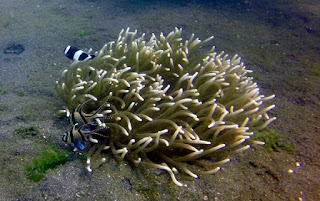The fact that the water below the surface was as calm as it was on the surface, with almost no current, can be a double edged sword. This site is so calm that the backwash that enters into the bay from East Java across the Bali Strait does not wash back out to sea as the bay is protected by the mangroves of Teluk Lampur that surround it. Sediment that is churned up by the Ketapang - Gilimanuk ferries enter the bay and take a while to settle. Even when it does, algae thrives due to the calmness water. As a result, visibility is usually poor, especially during the rainy season. With that much sediment suspended in the water, Secret Bay is also one of Bali’s best muck-dive sites.
We went right down to the business of diving but in a far more relaxed manner than say, at Tulamben because there were no waves to speak of and certainly no cobblestones to trip and stumble over. We waded in about 5 meters off the beach, turned right and went gently down to a shallow depth of 8 meters almost effortlessly. It is at this point that the real secret of this bay became apparent. The marine life was surprisingly abundant despite its proximity to human activity on the surface.
Secret Bay (Dive 12: 8o09'52"S 114o26'20"E):
On the first dive we were privileged to see:Secret Bay (Dive 13: 8o09'51"S 114o26'20"E):
We surfaced at 10:40. After the usual Surface Interval, we were back in the water at 11:56. Instead of turning right however, we turned left towards the pier:
I am Pegasus
At the end of our second dive, as we emerged from the water at a point where our equipment seemed to weigh more than we did, our instructor stopped us in our tracks to look at a creature no bigger than our little finger:
So rare in fact is the Pegasus Sea-Moth that not only is it listed by the IUCN as vulnerable but a diver could go through a lifetime of muck-diving and never see one of these little critters. Yet there it was, no more than a meter away from me and in not much more than half a meter of water.
What's that I hear you say - homework!
Although there is no denying that PADI is all about recreational diving, conservation of the sites that they dive at is of more than just a passing interest. If you are interested in a deeper understanding of marine life around Menjangan and more importantly, the communities that support and conserve it, I thoroughly recommend the following reading:- Report on Menjangan Island’s Coral Reef: A Bali Barat National Park Marine Protected Area, Orla Doherty, Carol Milner, Phillip Dustan, Stuart Campbell, Shinta Pardede, Tasrif Kartawijaya and Abigail Alling, Atoll Research Bulletin No. 599, 19 November 2013.
- SULU SULAWESI MARINE ECOREGION, Judy Oglethorpe, Global Conservation Program—World Wildlife Fund, October 1, 1999 - September 30, 2004.
- Conserving Reefs through Community Ownership and Enterprise, Simon Lyster, Darwin Initiative Project Annual Report # 2 - Revised, 1 April 2006 - 31 March 2007.























































